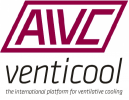The current development in building energy efficiency towards nearly zero energy buildings represents a number of new challenges to design and construction of buildings. One of the major new challenges is the increased need for cooling present in these highly insulated and airtight buildings, which is not only present in the summer period but also in the shoulder seasons and in offices even during occupied hours in winter. In most post‐occupancy studies of high performance buildings in European countries elevated temperature levels is the most reported problem, especially in residences.
Ventilative cooling can be an attractive and energy efficient solution to avoid overheating of both new and renovated buildings. Ventilation is already present in most buildings through mechanical and/or natural systems and it can both remove excess heat gains as well as by increasing air velocities widening the thermal comfort range. As cooling becomes a need also outside the summer period the possibilities of utilizing the cooling potential of low temperature outdoor air increases considerably.
This is the reason why the interest in ventilative cooling has increased in the last few years and a number of new initiatives have arisen with the purpose to raise awareness of the technology, to overcome perceived barriers and to develop the technology for future application.
The objective of this workshop was to discuss how and when strategies for increased ventilation with outdoor air can reduce the cooling load while maintaining good indoor environmental quality? This includes:
- presentation of built examples to document the need and potential of ventilative cooling as well as the status of present approaches
- discussion and identification of the design challenges related to prediction and evaluation of the cooling need and the risk of overheating in high performance buildings
- presentation and discussion of perceived barriers and challenges in standards and existing building regulations for application of ventilative cooling
- presentation and discussion of new ideas and solutions
In addition to the workshop proceedings, an expected outcome of the workshop included guidance and suggestions to focus areas for new activities for the venticool platform and R&D directions for the new research activity of the International Energy Agency (IEA): “ECBCS Annex 62 Ventilative Cooling”.





